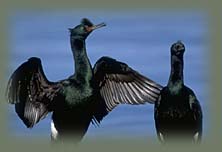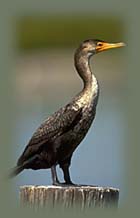| Raging
Cormorants! Why the Cormorant is the Official Bird of alt.support.menopause     
The Cormorant Origin Story Pamela
Dean Dyer-Bennet
Fascinating Cormorant Facts A large and
voracious sea-bird (Phalacrocorax carbo), about 3 feet in length,
and of a lustrous black colour, widely diffused over the northern hemisphere
and both sides of the Atlantic. Also the name of the genus, including
about 25 species, some of which are found in all maritime parts of the
world.
C. 1320 Orpheo
296 in Ritson Met. Rom. II. 260 Of game they fonde grete haunt,
Fesaunt, heron, and cormerant.
C. 1381 Chaucer Parl.
Foules 362 The hote cormeraunt of glotonye. The Double-Crested Cormorant
Oxford English
Dictionary 
 also
called SHAG, any member of about 26 to 30 species of water birds comprising
the family Phalacrocoracidae (order Pelecaniformes). In the Orient and
elsewhere these glossy black underwater swimmers have been tamed for fishing.
Cormorants dive for and feed mainly on fish of little value to man. Guano
produced by cormorants is valued as a fertilizer. also
called SHAG, any member of about 26 to 30 species of water birds comprising
the family Phalacrocoracidae (order Pelecaniformes). In the Orient and
elsewhere these glossy black underwater swimmers have been tamed for fishing.
Cormorants dive for and feed mainly on fish of little value to man. Guano
produced by cormorants is valued as a fertilizer.
Cormorants inhabit seacoasts, lakes, and some rivers. The nest may be made of seaweed and guano on a cliff or of sticks in a bush or tree. The two to four chalky eggs, pale blue when fresh, hatch in three to five weeks, and the young mature in the third year. Cormorants have a long hook-tipped bill, patches of bare skin on the face, and a small gular sac (throat pouch). The largest and most widespread species is the common, or great, cormorant, Phalacrocorax carbo; white-cheeked, and up to 100 cm (40 inches) long, it breeds from eastern Canada to Iceland, across Eurasia to Australia and New Zealand, and in parts of Africa. It and the slightly smaller Japanese cormorant, P. capillatus, are the species trained for fishing. The most important guano producers are the Peruvian cormorant, or guanay, P. bougainvillii, and the Cape cormorant, P. capensis, of coastal southern Africa. Encyclopaedia Britannica     
Cormorant
Links
The Double Crested Cormorant
Great Cormorant
Pygmy Cormorant
Cormorant
Replacement Therapy -- Successes and Side-Effects
Cormorants
as Trained Fishers
Cormorants in Central Park (photos by Laura and her husband)
NOTE: All photographs on this page (except the small one of Laura) are copyright © Don Baccus and are adapted here by permission. Animations by an anonymous menobabe.     
|
 "I
was hiking with a sweetie of mine on one of those days when, as Pat
Kight says, they have turned up the gravity -- when one is immensely
tired for no reason, it's a great effort to put one foot in front of
the other. I was lagging behind. My sweetie asked me if I was all right.
"Oh, yes," I said, "it's only hormones." My sweetie misheard me to say,
"It's only cormorants," and from then on I was afflicted by cormorants.
A few days later when I loudly expressed my displeasure at some minor
kitchen mishap, the same sweetie asked me, "Was that those cormorants
yelling in the kitchen?"
"I
was hiking with a sweetie of mine on one of those days when, as Pat
Kight says, they have turned up the gravity -- when one is immensely
tired for no reason, it's a great effort to put one foot in front of
the other. I was lagging behind. My sweetie asked me if I was all right.
"Oh, yes," I said, "it's only hormones." My sweetie misheard me to say,
"It's only cormorants," and from then on I was afflicted by cormorants.
A few days later when I loudly expressed my displeasure at some minor
kitchen mishap, the same sweetie asked me, "Was that those cormorants
yelling in the kitchen?"
 cormorant
cormorant
